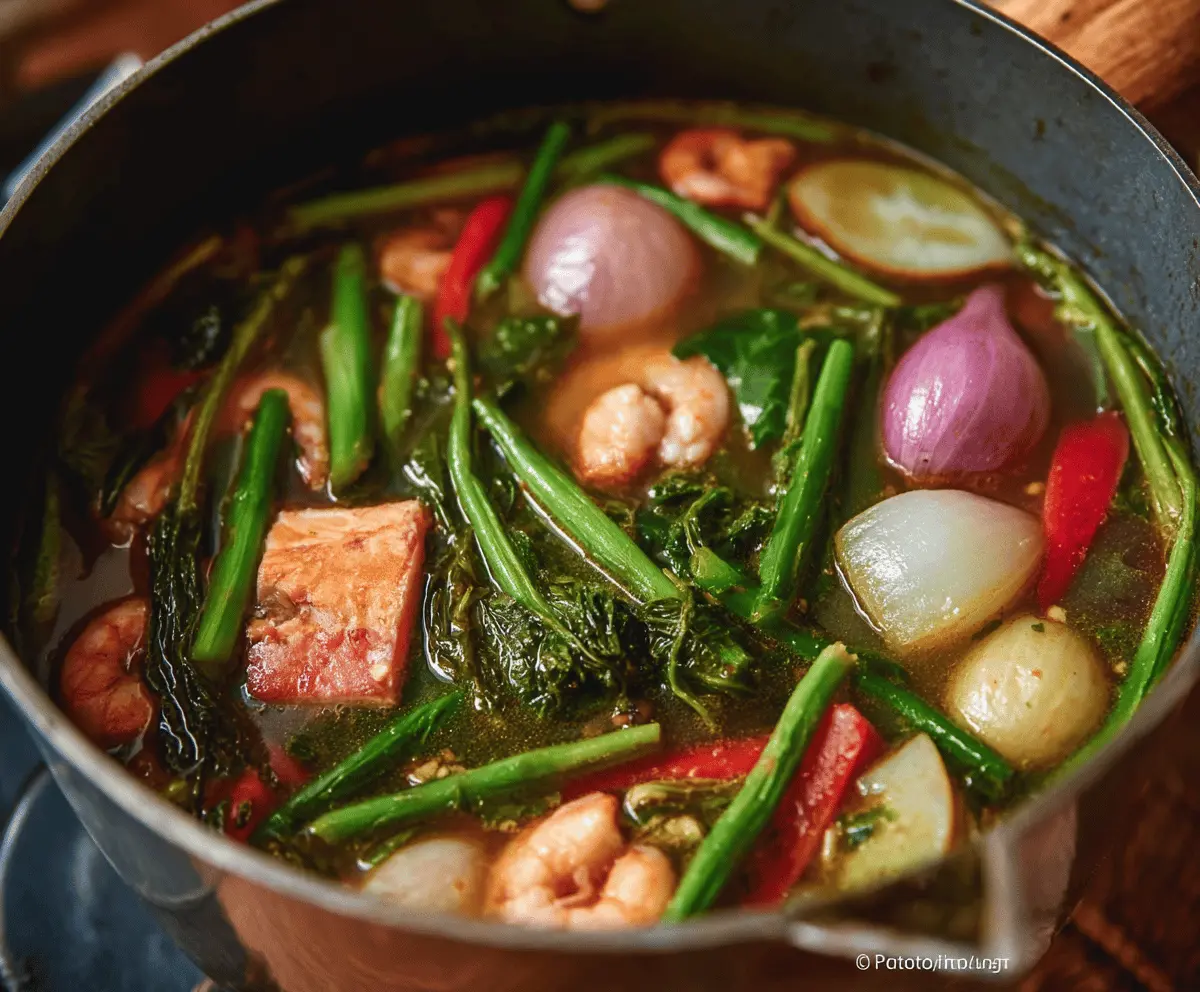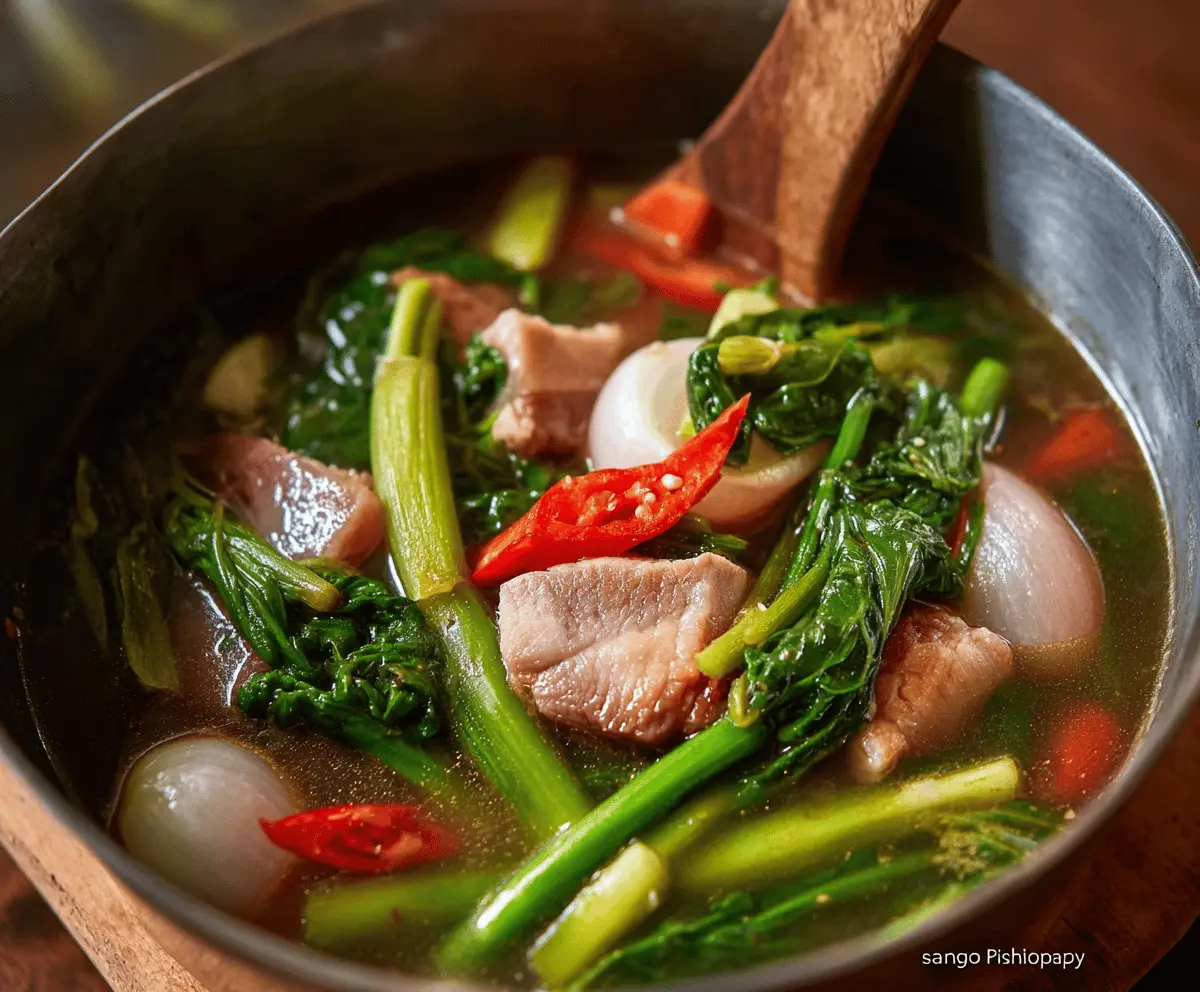Pork Sinigang is a tasty Filipino soup that’s both sour and savory. It’s made with tender pork, fresh veggies, and a delightful tamarind base that gives it that unique tangy flavor.
Whenever I make this dish, the smell fills the house with warmth! It’s perfect for family gatherings, and trust me, everyone will want seconds as they enjoy the cozy broth together.
Key Ingredients & Substitutions
Pork: Pork belly or shoulder gives great flavor and tenderness. If you’re looking for a leaner option, you can use pork loin. For a different taste, try substituting with beef or shrimp.
Tamarind: The traditional souring agent, fresh tamarind is the best, but if unavailable, a tamarind soup base mix works well. You can also try lime or lemon juice for a quick alternative, though the flavor will differ slightly.
Kangkong (Water Spinach): It’s great for sinigang but if you can’t find it, you can use spinach or bok choy. Just keep the cooking time brief to maintain their freshness.
Daikon Radish: This adds texture and taste. If it’s hard to find, you can swap with regular radish or turnip, or simply skip it if you prefer.
What’s the Best Way to Get the Pork Tender?
The key to tender pork in sinigang is simmering it slowly. Here’s how to do it right:
- Start with medium heat after browning the pork; this prevents toughening the meat.
- Let it simmer for 1 to 1.5 hours—this softens the meat perfectly.
- Check occasionally, adding water if the level gets too low.
Slow cooking helps the flavors deepen and the meat become melt-in-your-mouth tender!
How Can I Perfectly Balance the Sourness of the Soup?
Finding the right level of sourness is crucial in sinigang. Here’s how you can master it:
- Start with the recommended tamarind mix or pulp and taste the broth as you go.
- If you want it sourer, gradually add more tamarind mix or fresh pulp, mixing well before tasting again.
- Don’t forget to adjust with salt after balancing sourness—it enhances all flavors!
Remember, it’s about personal preference—go with what makes your taste buds happy!

“`html
How to Make Pork Sinigang
Ingredients You’ll Need:
Pork and Vegetables:
- 1.5 lbs pork (pork belly or pork shoulder), cut into chunks
- 1 medium onion, quartered
- 2 medium tomatoes, quartered
- 2-3 pieces green chili peppers (e.g., finger chili or jalapeño)
- 1 bundle of kangkong (water spinach) or similar leafy greens
- 1 cup daikon radish, sliced (can substitute with white radish)
- 1 cup long green beans, cut into 2-inch pieces
- 2 medium taro roots, peeled and cut into chunks (optional)
For the Broth:
- 8 cups water
- 1 packet tamarind soup base mix (sinigang mix) or 1 cup fresh tamarind pulp
- 2 tablespoons fish sauce (patis)
- Salt to taste
- 1 tablespoon cooking oil
Time Needed:
This recipe will take about 15-20 minutes for preparation and around 1.5 hours for cooking. So, set aside roughly 2 hours to enjoy making this flavorful dish!
Step-by-Step Instructions:
1. Sauté the Base Flavors:
Heat the cooking oil in a large pot over medium heat. Once hot, add the quartered onions and tomatoes. Sauté them until they become aromatic and the tomatoes soften, which should take about 5 minutes.
2. Brown the Pork:
Next, add the pork chunks to the pot. Cook, stirring occasionally, until the pork is lightly browned. This step will enhance the flavor of the broth!
3. Make the Broth:
Pour in the 8 cups of water and bring it to a boil. You’ll want to skim off any scum that rises to keep your broth nice and clear. It usually takes a few minutes for this to happen.
4. Simmer the Pork:
Now, reduce the heat to a gentle simmer and let the pork cook for about 1 to 1.5 hours, or until it’s tender and flavorful. Keep an eye on it and stir occasionally!
5. Add Root Vegetables:
Once the pork is tender, it’s time to add the taro roots and daikon radish. Continue simmering for another 15 minutes until they start to soften.
6. Bring in the Sourness:
Stir in your tamarind soup base mix or fresh tamarind pulp. Taste and adjust the sourness by adding more if you prefer it tangier!
7. Add Green Beans and Chilies:
Next, add the green chili peppers and long green beans. Let them simmer for about 5-7 minutes, just until they are tender but still crisp.
8. Season:
Now it’s time to season your soup! Add fish sauce and salt to taste. This step helps bring all the flavors together.
9. Final Touch – Leafy Greens:
Finally, toss in the kangkong or your chosen leafy greens. Cook just until they’re wilted, which should take about 2-3 minutes. We want them to keep their vibrant color!
10. Serve and Enjoy:
Turn off the heat and serve your delicious Pork Sinigang hot, ideally with a side of steamed rice to complement the dish. Enjoy each comforting spoonful!
“`
This HTML formatted recipe will be easy for readers to follow and replicate the delightful flavors of Pork Sinigang at home. Enjoy cooking!

Can I Use Frozen Pork for This Recipe?
Yes, you can use frozen pork! Just make sure to fully thaw it in the refrigerator overnight or use the defrost setting on your microwave. Thawing properly helps ensure even cooking and tender meat.
How Can I Make Sinigang Spicier?
If you want to ramp up the heat, you can add more green chili peppers or include sliced fresh chili along with the others. For a different kick, try using crushed red pepper flakes or chili powder while simmering!
Can I Prep This Dish Ahead of Time?
Absolutely! You can make the soup up to a day in advance. Just cool it completely before storing in an airtight container in the fridge. When ready to eat, reheat gently on the stove, adding a splash of water or more tamarind if needed.
How Should I Store Leftovers?
Store any leftovers in an airtight container in the refrigerator for up to 3 days. Reheat on the stove or in the microwave, stirring occasionally to ensure even warming. Avoid boiling to prevent the greens from overcooking!


